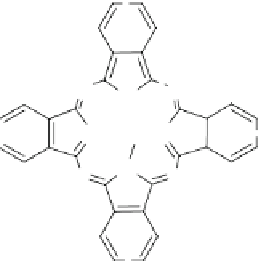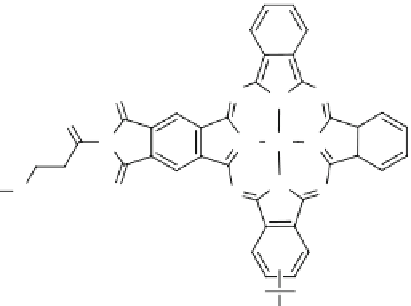Biomedical Engineering Reference
In-Depth Information
Phthalocyanines have been also widely investigated due to their high triplet
quantum yield and long-living triplet state. For example, Burda and co-workers
(Dayal et al.
2006
) investigated energy transfer and
1
O
2
production by varying
donor-acceptor distance, number of silicon
Pc
coupled to the QDs, terminal func-
tional group in
Pc
. Some other groups were interested in tetrasulfonated aluminum
Pc
(Fig.
32
) (Idowu et al.
2008
) or octacarboxymetallophthalocyanines (Moeno
et al.
2010
).
The linking of QDs to low symmetry
Pc
s has been reported for the first time very
recently by Chidawanyika et al. (
2010
). CdTe mercaptopropionic acid (MPA) QDs
have been linked to a tris [9(10),16(17),23(24)-tert-butyl]imidophtalocyaninato
Zinc (II)
Pc
(Fig.
33
) and the authors showed that the linkage increased the FRET
efficiency. The team of Nyokong (Erdogmus et al.
2010
; Moeno et al.
2010
) devel-
oped a system with zinc phthalocyanines (Fig.
34
) and MPA capped CdTe QDs.
They could observe a slight increase in the triplet state quantum yields and lifetime
SO
3
Na
Cl
N
N
N
N
Al
N
SO
3
Na
NaO
3
S
N
N
N
Fig. 32
Tetrasulfonated
aluminum
Pc
SO
3
Na
O
N
N
N
O
Zn
N
N
N
N
QD
S
O
N
N
Fig. 33
Tris [9(10),16(17),23(24)-tert-butyl]imidophtalocyaninato Zinc (II)
Pc






Search WWH ::

Custom Search